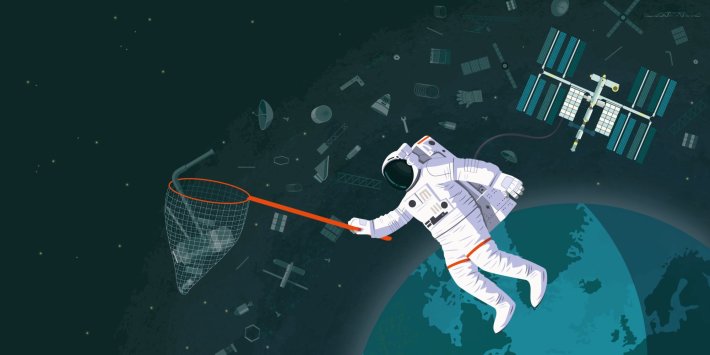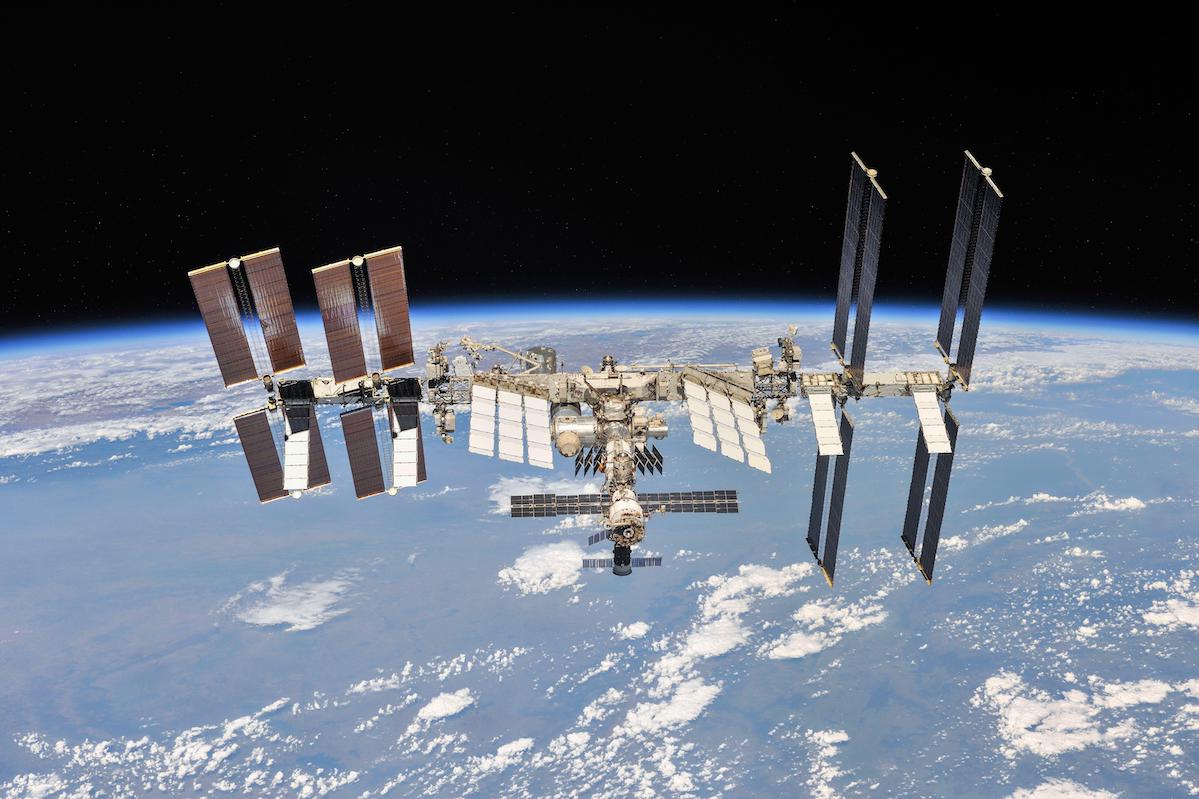Waste of space: The danger posed by orbital junk

Tali Fraser
POLITICS HOME
@TaliFraser
13 January, 2024
Sending satellites and other objects into space is getting ever easier and cheaper but, as Tali Fraser reports, the mess left behind is dangerous and without action is posing an ever greater risk. Illustration by Tracy Worrall
It started with a single glove in 1965. Approaching 60 years later there are around 130 million pieces of humanity’s detritus circling our planet.
Of the objects in Earth’s orbit, 75 per cent are said to be “space junk”, from old satellites to spacecraft – and almost every space mission has the ability to produce more, leaving low-Earth orbit (LEO) looking like a landfill.
The astronauts of the International Space Station (ISS) have enough to consider without the worry of coming under attack from thousands of pieces of tiny space shrapnel. But that possibility is rapidly increasing as the amount of “space junk” continues to grow following the launch of several multi-satellites constellations.
Only 33,000 items of “space junk” are trackable, the rest being too small to monitor – and it is this smaller, untrackable, “junk” that poses the greatest threat to the ISS, which is unable to manoeuvre around them.
“That region is quite benign but it’s also becoming much more congested and busy because of the way in which we’re building up the large constellations.”
These satellite constellations, such as the near 5,000 satellites of Elon Musk’s SpaceX company Starlink, increase the number of orbital objects, the occurrence of collisions and the amount of debris left in space.
Astronauts have created their own space junk, too. After NASA’s Ed White dropped his right glove in 1965 and became the first space litterer, there has been a tool bag left behind on a space walk last year, a camera that drifted away during a 2007 space walk, a spatula and even an Andy Warhol drawing (left behind by the Apollo 12 mission).
It’s becoming much more congested and busy because of the way in which we’re building up the large constellations
Chair of the Space APPG Mark Garnier MP succinctly explains the human nature of “space junk”: “We’re one of nine planets, orbiting one of a billion stars in the galaxy, and there are a trillion galaxies out there, but sure enough, humans can mess up the space around our planet! And if you get too much junk out there, you won’t be able to get through it.”
The fear of growing space debris is spelled out in the Kessler Syndrome, named after the former NASA scientist Donald Kessler, who in a 1978 paper described a scenario where LEO becomes so crowded, with collisions occurring so often, that it makes orbital space unusable.
Space debris expert Chantal Cappelletti says: “The main problem is that in space there is no real law. There is some agreement amongst some countries, but with others there is nothing.”
The major accepted rule, assistant professor Cappelletti highlights, emerged from the Inter-Agency Space Debris Coordination Committee and says that decommissioned satellites should deorbit within 25 years to reduce atmospheric density.
UK science minister Andrew Griffith tells The House: “Space debris is quite dangerous. We’ve seen quite a lot of near misses in space, it can obscure the view of satellites, it can jeopardise certain orbital positions.”
Anything orbiting earth moves quickly, with space debris being no different – travelling at roughly 10 kilometres per second. If a satellite is hit by something the size of a tennis ball, that could destroy it completely.

Even a one-centimetre object – the size of a Cheerio – could disable critical instruments on the International Space Station, and anything larger could penetrate its protective shields. There are around 670,000 objects larger than a Cheerio in space.
What exactly would “space sustainability”, as it is billed in the UK’s space strategy, involve to clear up “space junk”? “One of the clear things is you need to be able to track it,” Griffith adds, something the UK has the potential to be a “world leader” on. For example, British-based company ODIN Space was recently able to demonstrate the tracking of tiny pieces of space junk, too small to register using existing methods, while in orbit.
“We have really positioned ourselves to be world leaders in this field. Definitely more so than the US, Russia and China, who are the leading sources of space debris,” says Professor Lewis.
“But we have to bring everybody along with us. That’s one of the most difficult things.”
There are two main approaches to dealing with space debris. One is to stop it at the source and try to prevent or mitigate the creation of any new debris. For example, designing spacecraft not to release any parts when they’re operating, avoid blowing up as far as possible and, when the mission is finished, removing any debris. The second option is to remove current space debris, which is often referred to as remediation or active debris removal.
Garnier advocates for “deorbiting”, to take derelict satellites and other space debris out of orbit, alongside extending the life of a spacecraft and the development of new electric plasma technology in the UK.
While Cappelletti adds: “Something we have done in the past was to have an autonomous system because it is possible, when launching a satellite, that it fails for some reason. If there is a way the deployment system can open in any case and deorbit, you can prevent having a very overcrowded low-Earth orbit.”
Companies are informing regulation, too. The Earth Space Sustainability Initiative (ESSI), an organisation that Professor Lewis is a member of, produced a memorandum of principles setting out a vision for space sustainability.
They set a goal of having 30 companies sign the memorandum – which calls for limiting further generation of debris, waste and pollution in space, alongside enabling measures to remedy the impacts that have already taken place – but got the backing of 130.
Professor Lewis says: “Regulation needs to be approached in a way that is driven by industry consensus. Gone are the days where governments use space exclusively.”
But governments are taking certain measures into their own hands as well, with the US in recent months issuing its first ever fine ($150,000) to a company for its space junk, after Dish Network failed to move an old satellite far enough away from others in use.
It is a move that Cappelletti supports for dealing with private companies but warns against a blanking fine system that would “jeopardise” research in space from other sectors like universities.
The main problem is that in space there is no real law. There is some agreement amongst some countries, but with others there is nothing
Updating the technology used in space is often flagged as another way to tackle a further increase in space debris. “We’re designing spacecrafts more or less the same way we’ve been designing for many years and they may sometimes blow up,” Professor Lewis says.
“There is an argument for saying that we need to rethink how we design and operate spacecraft so that we essentially have a circular economy in space where we reuse and repurpose things.”
Garnier agrees there is a need for “longevity” and flags that there are people working on technology where “if the spacecraft is valuable enough, a probe goes up the engine belt, and can attach another spacecraft to it, which can then continue to fly around”.
The best solution may turn out to be pleasingly low-tech, wooden satellites – developed by NASA and Japanese scientists – that would burn up and become a gas upon re-entering the atmosphere where the metal ones would become fine particles, leaving no litter.
No comments:
Post a Comment